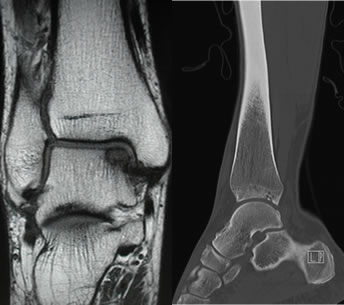in Foot and Ankle Surgery and Reconstruction
The ankle joint is a hinge joint with strong ligaments on either side of it. The two main groups of ligaments are the lateral ligaments found on the outside of the leg just below the ankle bone (fibula) and the medial ligaments on the inside of the leg just below the ankle bone (medial malleolus of the tibia). The lateral ligaments called the ATFL (anterior talofibular ligament) and the CFL (calcaneofibular ligament) are more commonly injured by twisting for example in a simple ankle sprain.

Many patients first injure their lateral ligaments playing sports where they twist awkwardly and the foot turns inwards (an inversion injury) causing instant pain and swelling on the ankle. It can happen however by simply stepping off a kerb, or missing your footing on an uneven surface.
The main reason people seek medical attention is because of pain around the outside of the ankle. Patients often complain that they are unable to walk properly. The ankle usually swells up and bruising can appear, typically on the outside of the ankle, but eventually the whole foot can appear bruised.
Most will get better with simple remedies classically Rest, Ice, Compression and Elevation, after a few days. Usually you can walk with an ankle sprain but with a limp. If there is a significant deformity or swelling and you are unable to put weight through it at all then its best to seek medical advice, because an X-Ray may be required to exclude a bony fracture.
Many people sprain their ankles and get back to full activity without any formal therapy. These may be milder sprains. If you are concerned its safest to seek medical advice and then specialist physiotherapy can be arranged. This is designed to assist you with your recovery by regaining your ankle movement with simple exercises, building up your muscle strength with resisted exercises and therabands and improving your stability and balance on the ankle using techniques like wobble-boards. This are all tailored to prevent this happening again.
If pain persists in the ankle for more than 3 months then it is possible that more damage had occurred initially than just a ligament sprain. One possible reason is that part of the bone surface inside the joint was chipped and the cartilage damaged (osteochondral defect) and this can be evaluated with special scans such as MRI or CT scans. Your surgeon will assess and take the necessary steps with you.

This may be an indication of chronic damage to the lateral ligaments and instability of the ankle. If you have completed an intensive course of physiotherapy and you are still having problems then you will need clinical assessment by surgeon. It is likely that an X-Ray and an MRI scan will be performed (if not already by the physiotherapist) to further assess your ankle and establish the exact problem. If you indeed have ligament instability then further treatments likely involving surgery will be discussed.
No. You may want to pursue further non-operative treatments such as wearing a supportive brace inside your shoes especially during sporting activities or even on normal walking. Further physiotherapy can be done but it is likely that your symptoms will persist. Some people may even decide to change their lifestyle to eliminate certain sporting activities that make the problem worse.
Yes. If you suffer from chromic ankle instability problems the recurrent twisting can damage the bone surface inside the joint and the cartilage on the bone can be chipped off (osteochondral defect) and you can continue with pain and swelling. Gradually the joint could become more damaged and even develop arthritis in the joint so its best to get assessed sooner rather than later.